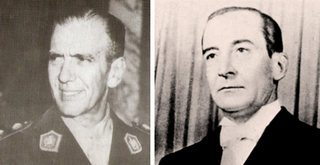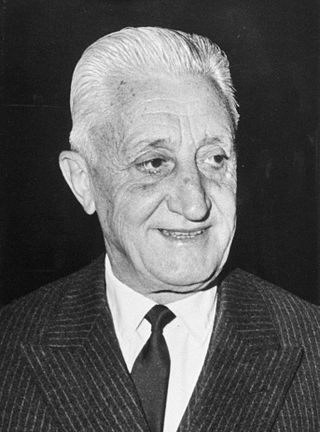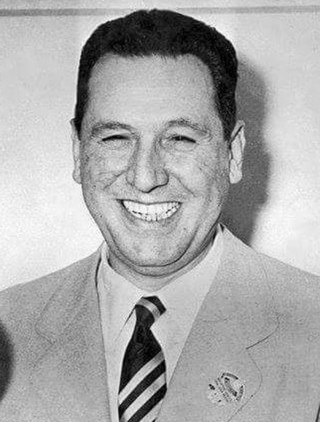
Arturo Umberto Illia was an Argentine politician and physician, who was President of Argentina from 12 October 1963, to 28 June 1966. He was part of the Radical Civic Union, and the People's Radical Civic Union during his presidency.

José María Guido Cibeira was President of Argentina from 29 March 1962 to 12 October 1963, serving as the head of a provisional civilian government after the Argentine military overthrew President Arturo Frondizi. Guido's nineteen months in office were characterized by a severe economic recession, open conflict between competing factions within the armed forces, and anti-democratic measures including continued proscription of Peronists from Argentine politics. Yet Guido, with critical support from the "legalist" faction of the military, prevailed in his mission to return Argentina to constitutional government with a general election held on 7 July 1963.

Arturo Frondizi Ércoli was an Argentine lawyer, journalist, teacher and politician, who was elected President of Argentina and ruled between May 1, 1958, and March 29, 1962, when he was overthrown by a military coup.

The Radical Civic Union is a major political party in Argentina. It has reached the national government on ten occasions, making it one of the most historically important parties. Ideologically, the party has stood for radicalism, secularism and universal suffrage. Especially during the 1970s and 1980s, it was perceived as a strong advocate for human rights. Its factions however, have been more heterogeneous, ranging from conservative liberalism to social democracy.

The Intransigent Radical Civic Union was a political party of Argentina.

Revolución Libertadora as it named itself, was the civic-military dictatorship that ruled the Republic of Argentina after overthrowing President Juan Domingo Perón, shutting down the National Congress, removing members of the Supreme Court, as well as provincial, municipal, and university authorities, and placing the entire Judiciary under commission. This occurred through a coup d'état on 16 September 1955. After two years, it organized conditional elections, which transferred power to a government led by the Radical Arturo Frondizi on 1 May 1958, who would also be overthrown in 1962.

Isaac Francisco Rojas Madariaga was an Argentine Admiral of the Navy and de facto Vice President of Argentina. He joined the Argentine Navy and had an unremarkable career until the 1946 election of Juan Perón.

Álvaro Carlos Alsogaray was an Argentine politician and economist. He has been known for being Minister of Economy on two occasions, Minister of Industry, Ambassador to the United States, and National Deputy. He played an important role with the Azules in the confrontation against the Colorados. He promoted economic liberalism in the second half of the 20th century and founded the political party Unión del Centro Democrático (UCeDé).

The Argentine general election of 1963 was held on 7 July. Voters chose both the President and their legislators; with a turnout of 85.6%, resulting in the election of Arturo Illia as President of Argentina.
The history of Argentina can be divided into four main parts: the pre-Columbian time or early history, the colonial period (1536–1809), the period of nation-building (1810–1880), and the history of modern Argentina.

General elections were held in Argentina on 11 November 1951. Voters chose both the President of Argentina and their legislators. This was the first election in the country to have enfranchised women at the national level. Turnout was around 88%.

The Argentine general election of 1958 was held on 23 February. Voters chose both the President and their legislators and with a turnout of 90.6%.

The Integration and Development Movement is a developmentalist political party founded by Arturo Frondizi in Argentina. It is member of La Libertad Avanza.

The Argentine legislative elections of 1965 were held on 14 March. Voters chose their legislators with a turnout of 83%.

Andrés Framini was an Argentine labor leader and politician.

The Argentine legislative elections of 1962 was held on 18 March. Voters chose their legislators and governors; with a turnout of 85.7%.
The Argentine Constituent Assembly election of 1957 was held on 28 July. Voters chose delegates to the assembly, and with a turnout of 90.1%.
In Argentina, there were seven coups d'état during the 20th century: in 1930, 1943, 1955, 1962, 1966, 1976, and 1981. The first four established interim dictatorships, while the fifth and sixth established dictatorships of permanent type on the model of a bureaucratic-authoritarian state. The latter two conducted a Dirty War in the line of state terrorism, in which human rights were systematically violated and there were tens of thousands of forced disappearances.

Juan Atilio Bramuglia was an Argentine labor lawyer who served as Minister of Foreign Affairs during the administration of President Juan Perón.

The Federal Popular Union, formerly the Popular Union until 2020, is a centre-right political party in Argentina rooted in Peronism. Established by Juan Atilio Bramuglia as a contingency for Peronists displaced by the 1955 military coup against the populist President Juan Perón, it became a "neo-Peronist" alternative to the exiled leader's line, and subsequently, an alternative to the successive dominant factions in the Justicialist Party.


















